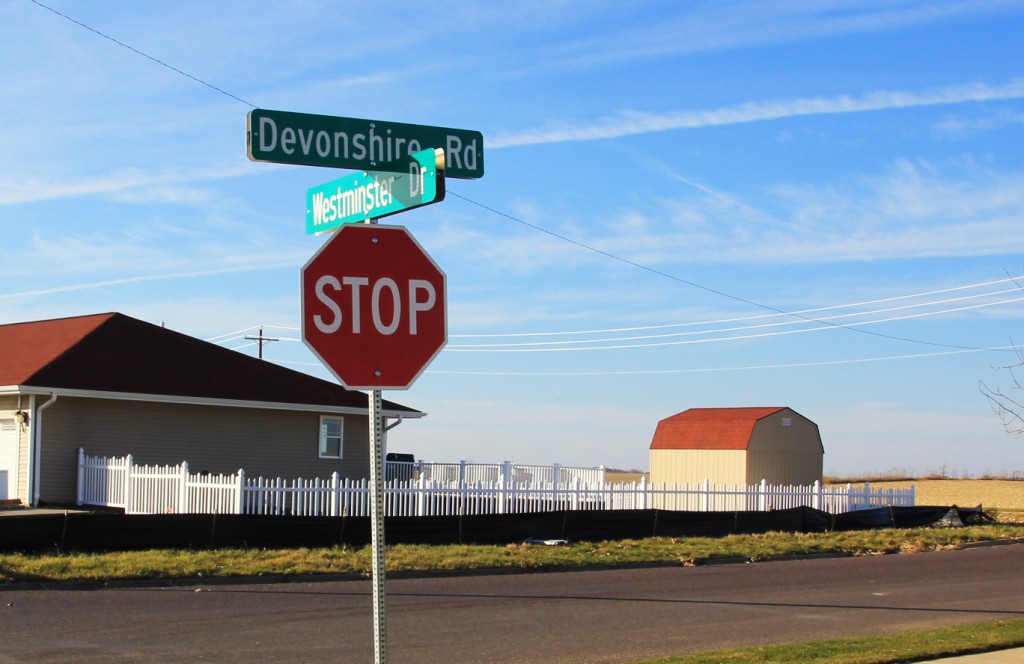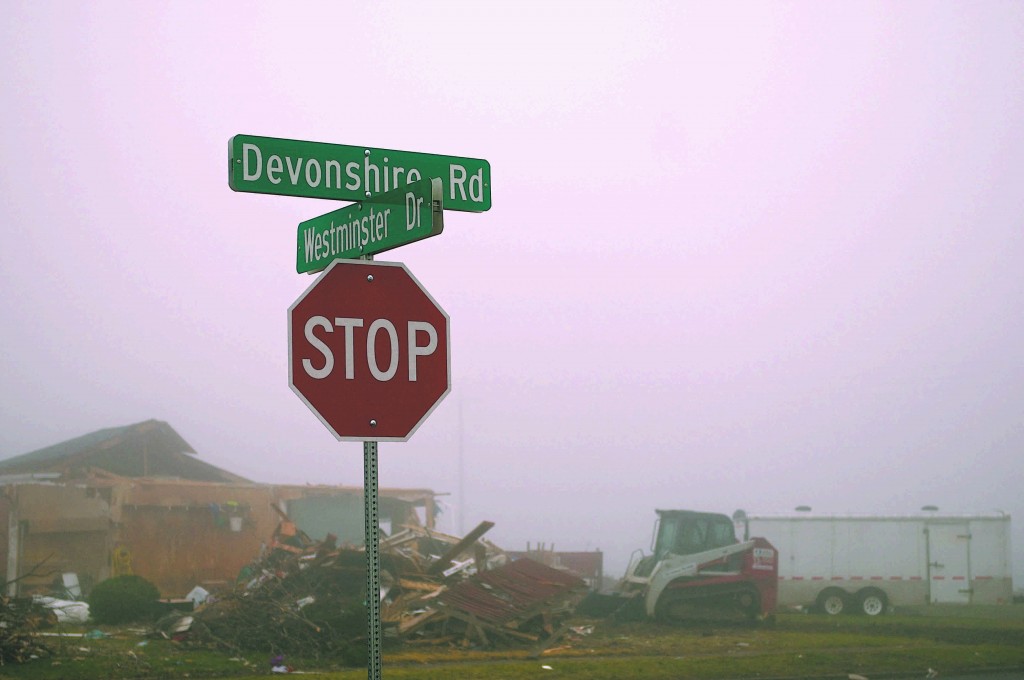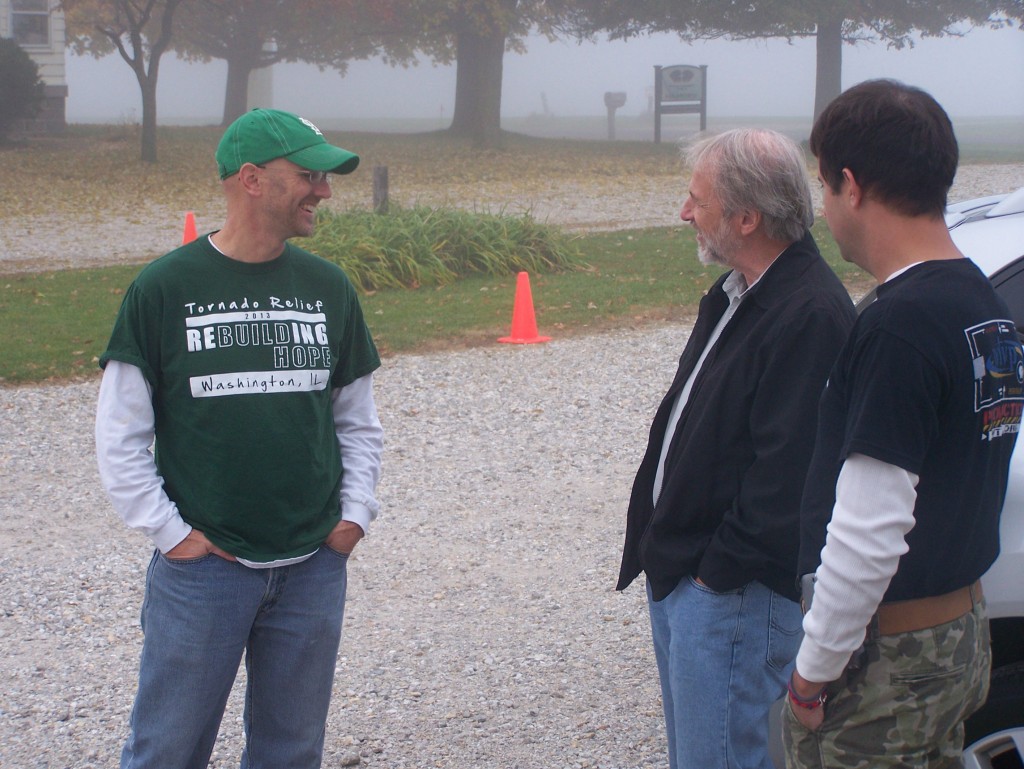A Year Later, Washington Tornado Recovery Slow, Steady
November 12, 2014One year after the deadly tornado that swept through the heart of Washington, residents west of Washington Square (pictured) are accelerating efforts to rebuild over 1,000 homes destroyed by the Nov. 17, 2013, EF-4 rated tornado. Photo by Tim Alexander.
by Tim Alexander
As Homes Continue To Be Rebuilt, So Too Do Lives
WASHINGTON, Ill. – The deadly tornado swept into central Illinois from the southwest, skipping the Illinois River from west to east sides, obliterating homes and businesses in scattered locations in East Peoria, Morton and Washington before exhausting itself northeast of Washington. Houses were unroofed and wrecked, huge trees were uprooted, glass windows were blown out, telephone lines were torn down, and automobiles were lifted from the streets, as media reported the following day.
In Washington, in 1924, the United Methodist Church shook from a similar storm, sustaining damage to its tower and causing the massive brass bell, constructed of solid bronze and silver during the 1830’s, to topple 65 feet to the ground. The bell suffered a twist to its frame, but was restored and put back into use. The bell, now retired, serves as a silent reminder of the tornado, which killed eight people in central Illinois, though none in Washington. It is currently ensconced in the great room of Crossroads United Methodist Church.
An EF-4 twister hit those same three cities on November 17, 2013, causing three deaths and the loss of over 1,000 homes and businesses in Washington. And the Washington United Methodist Church would once again be a part of a deadly tornado’s legacy.
News Bulletin reporter Tim Alexander revisited the scene of destruction that followed the November 17, 2013 tornado. What he saw was hope on a grand scale and rebuilding of every kind. Photos by Tim Alexander.
Populace Huddled In Prayer
Washington, a town of some 15,000 souls established by pioneer William Holland in 1825, has long been marked by its conservative, church going populace. It is no surprise that a significant number of potential victims in the path of the storm were massed in various churches that went untouched by the estimated half-mile wide tornado, which cut a swath through the central portion of the city west of Washington Square but largely spared all schools, nursing homes and houses of worship. Many people regard the timing of the tornado– it hit shortly before 11 a.m. on Sunday morning– as a form of divine intervention that literally prevented hundreds of deaths and injuries.
Around 400 to 500 parishioners were attending the 10 a.m. contemporary worship service that morning at Crossroads United Methodist Church, located just north of the square near the intersection of North Main Street and U.S. Route 24, when the congregation literally began to buzz from the sound of weather alerts issued to smartphone users. Through a window, Pastor Tom Goodell and other church leaders saw the massive twister approaching from the southeast, churning through Devonshire Estates and heading, seemingly, straight for the church.
As during the storm of 1924, the church again literally shook from the force of a tornado. But unlike that long ago storm, which hit during the darkness of the 3 a.m. hour, church leaders this time had a chance to react.
“We had drilled for this, so we made the decision to move everyone into our storm shelters that were built with the church in 2001,” recalled Goodell. “We managed to do this probably within about three or four minutes. We were pretty prepared.”
When the barometric pressure in the church dropped dramatically, Goodell and the huddled congregation knew the tornado was upon them. But the church and it’s inhabitants were to be spared. The funnel suddenly veered further northeast, skipping past the church and continuing into the countryside, damaging farmhouses and outbuildings north and east of the city but causing no further serious injuries. Very minor damage was done to Crossroads Church, and all parishioners emerged safely from the church.
Across the city, similar scenes were playing out in nearly every congregation. Shaken but physically unharmed churchgoers of all denominations dusted themselves off and began to shift their focus to helping survivors.
Churches Leading Volunteer Recovery Efforts
Just a few minutes after the killer tornado passed through Washington and buzzed Crossroads United Methodist Church, a glass and debris-covered motorist arrived at the church in search of aid and comfort. No one knew who the woman was– names were not exchanged in the midst of the chaos– and she remains unidentified today, according to Pastor Goodell. But when members of the church, some of them nurses, set up triage and immediately began to administer aid to the stranger, “Jane Doe” became the first official recipient of tornado relief efforts from Crossroads Church volunteers.
Today, the number of recipients has reached into the thousands.
“We immediately began to work with the Red Cross, and we got a generator in (the church) because we needed power,” Goodell said of the church’s initial tornado relief efforts. “When the lights came on later on Sunday, they became a beacon inviting people to come inside the church. More than thirty people stayed in the church that night.”
In the next few weeks, Crossroads, with the aid of volunteers throughout central Illinois and beyond, would greatly expand their relief efforts. Some 30,000 hot meals were dispensed to affected residents and volunteers before the end of November, according to Goodell.
A mile or so away at Five Points Washington, Bethany Community Baptist Church services were also disrupted by the tornado that morning. Passing just 400 yards behind and to the west of the community center, where Bethany conducts services, the funnel cloud leveled hundreds of residential homes and nearly scored a hit on the nearby, 158-bed Washington Christian Village nursing home before veering off in another direction.
“After the storm went through, the church members began helping the Five Points staff to set up a bit of a triage center. People were walking in wearing only shorts, shoes and t-shirts and carrying their dogs– it was all they had left,” recalled Bethany Church Pastor Ben Davidson, a Washington resident.
“That evening when I rode my bike home I thought about (organizing) volunteers. I had been a volunteer in Slidell, Louisiana, after Hurricane Katrina. I gathered thoughts from others in our church, and we started sending volunteers out into the community. We then put out an appeal on social media and on our website and it just exploded. The following Saturday we had 1,000 people show up to volunteer,” Davidson said.
As with the congregation of Crossroads United Methodist Church, Bethany accelerated their relief efforts as more needs arose. By November 1, more than 13, 350 volunteers had logged over 72,500 tornado relief work hours under the direction of Davidson and Bethany Church.
On a moist and foggy Saturday morning in late October of 2014, some four dozen volunteers reported to the Bethany Church farmhouse outside of Washington to help clean debris from lawns, cut weeded lots, move landscape brick or build storage sheds. One couple drove from the Chicago suburb of Clarendon Hills– braving a dangerous, near-impenetrable morning fog– to lend their skills to the recovery effort.
“Our community is very grateful to people like you,” Davidson told the couple, along with the other volunteers assembled at the Bethany farmhouse that morning.
Bethany and Crossroads churches are but two of the area congregations that have stepped up to provide invaluable resources, relief and comfort to Washington residents in the year following the storm. The leadership of the church community, under the suspices of the Washington Ministerial Association, has served as a point of pride in the still recovering community of Washington.
“All of the churches have had a role to play,” said Goodell, adding that congregations from Peoria and other surrounding communities have provided valuable resources and donations for tornado-stricken Washington residents in the past year, as well.
Bethany Community Church pastor Ben Davidson (left) directs volunteer efforts, now numbering over 13,000 people, from relief headquarters owned by the church on West Dutch Lane near Washington, before a late November, 2014 cleanup. Photo by Tim Alexander
Mental Health a Major Focus of Recovery
“Initially, people came to us for answers,” Goodell said of Crossroads Church’s evolving role in the Washington tornado relief effort. “Why did this happen? Is there a reason for the storm? I believe there was a meteorological reason for the storm. I don’t believe God sends those kinds of storms, and I don’t attribute the tornado to God. People who lost everything and people who lost nothing have struggled with that question.”
Crossroads began offering afflicted residents access to quality mental health care in the weeks and months after the storm as part of their ministerial relief package. Parishioners and others in the community reported feelings of fear, depression, anger, and even survivor’s guilt in the months after the tragedy, according to the Crossroads pastor.
Dr. Joy Miller, a licensed therapist with Joy Miller and Associates, agreed that all of the symptoms described by Goodell are typical of survivors of natural disasters.
“What we typically find is heightened anxiety, sometimes accompanied by depression,” said Miller. “We also see a lot of hypervigilance. You are always on the watch. You are always feeling like you have to be aware of everything around you. It’s like something has happened in your life that you couldn’t control, so you try to do everything you can, and be aware of everything, so that you can protect yourself. It’s a mechanism we use psychologically to try and create some kind of order.”
Lingering trauma from the tornado could also manifest itself in nagging physical maladies, Miller continued. “We see a lot of people with physical problems, such as stomach ailments, back aches, a variety of different (issues) that can continue for a really long time,” she said.
“For some people, there is a lot of hopelessness, and for others, a survivor’s guilt. We see people who feel they are not suffering like others are. This is really quite common.”
Children may harbor their own roster of symptoms of post-trauma stress associated with the tornado. To some degree the events of Nov. 17, 2013 will always remain with affected youth, Miller explained.
“It has been a year, but that doesn’t mean that young children still won’t have that separation anxiety, the fear that they could lose somebody close to them or the things around them. There could be issues with lack of focus and concentration, behavioral problems, sleep disturbances, even bedwetting,” Miller said. “Their whole lives have basically been turned upside down, and it’s very difficult to explain to a young child why things like this happen.”
Parents should remain diligent when seeking treatment for children suffering psychological effects from the storm, however.
“We need to remember that the children, many times, are the most resilient,” said Miller. The one year anniversary of the historical Washington tornado should compel those who are suffering, or whose loved ones are suffering from storm-related trauma to seek professional help facing lingering mental issues, Miller added.
“Right after a trauma such as this, people focus on (primary needs), on ‘fixing’ the problem,” she said. “But people now need to focus on their emotional needs, to find some meaning in the experience. This is a perfect time for people to seek understanding, and find ways to cope and heal.”
“Hope Lives On“ For Resilient Citizens
Opportunities for personal healing from psychological ravages inflicted by the 2013 Washington tornado present themselves in many shapes and forms. For many, simply talking about or putting their experiences and feelings onto paper can be a therapeutic form of healing, mental health experts agree. The Washington Historical Society and the Washington Public Library collaborated to provide a way for tornados survivors and others affected by the storm to discuss their feelings and experiences while recording and preserving local history.
The “Hope Lives On” project compiles written or recorded stories of survival and hope in the wake of the tornado’s devastation, according to Elyse Nicholson, a 23 year-old Eureka College graduate contracted by the library and historical society to assimilate and publish online the recorded testimonials of those affected by the tornado. The project’s website, www.hopelivesonproject.businesscatalyst.com, launches on November 17 and contains more than 50 first-hand accounts of the tornado and its aftermath donated by citizens through the project’s sponsors.
“We have stories submitted by everyone from 11 year-olds up to 96 year-olds, We get them handwritten and typed, some from people who are survivors of the tornado, volunteers and (former residents),” said Nicholson, who grew up on a small hay farm between Metamora and Eureka. “All of the stories are very important to us, and we are very humbled to be a part of this.”
These stories, perhaps more than any words that can be conveyed by a newspaper reporter, tell the true story of what survivors and those close to them endured.
“I am sure I was in shock the day of the tornado,” wrote Washington resident Claude Thomas. “It all felt like a dream, a very bad dream. I don’t think I shed a tear that day, but my eyes have teared up many times since that day. There isn’t a day goes by that I don’t think about the events of November 17, 2013. Thankfully we survived without a physical scratch, but I know there (are) emotional scars.”
Penning her thoughts last December, 57 year-old Deborah Smith of Washington noted that driving through the twisted wreckage of neighborhoods took her breath away a month after the disaster. “I’m trying hard to put it all into perspective and make some sense out of it all. Each time a new picture or video is posted I try hard to avoid looking at it, but to no avail. This has changed my life in ways I can’t explain, and my home wasn’t even touched,” Smith wrote.
“Like the day JFK died and the day we heard about the Challenger explosion and the morning of 9-11, I will always remember where I was on the morning of Nov. 17, 2013,” stated Maureen Hotkevich, who joined youngsters in her Sunday School class in singing “This Little Light” as the tornado passed through the city.
96 year-old Helen Sandmeyer wrote in her handwritten testimonial that she and her son, Jack, were preparing to head to Bernardi’s Restaurant for lunch when the tornado hit her home on Gillman Street. The pair were lucky to escape unharmed, she reported.
“Within a few seconds the roof of my house and shortly after, the back wall of my house were blown away. Furniture in the room moved in a circular movement and my son and I lost each other in the confusion. From out of nowhere came two neighbors– one to uncover my son from the falling debris; the other unceremoniously picked me up and dumped me into a nearby wheelbarrow and away we went. There was a collection of neighbors to see my arrival in the wheelbarrow. No, it wasn’t my first ride but many years had gone by since I’d had such a ride,” Sandmeyer stated.
“While all that booming and crashing and wishing was happening tears were running down our faces. I thought it was all over for us,” recalled Cassie Johnson, an 11 year-old whose mother, Paula, signed off on her submission. “The one thing that keeps me going after all this trauma in my life is knowing that life will be normal soon.”
Thanks to the unquenchable spirit and pride of the Washington community, civic and church leaders and a large, dedicated corps of volunteers, that day of normalcy may occur sooner rather than later for Johnson and other Washingtonians affected by the 2013 tornado.







